 German Empire (1901): SMS Roon, Yorck
German Empire (1901): SMS Roon, YorckWW1 German Cruisers
Irene class | SMS Gefion | SMS Hela | SMS Kaiserin Augusta | Victoria Louise class | Prinz Adalbert class | SMS Prinz Heinrich | SMS Fürst Bismarck | Roon class | Scharnhorst class | SMS BlücherBussard class | Gazelle class | Bremen class | Kolberg class | Königsberg class | Nautilus class | Magdeburg class | Dresden class | Graudenz class | Karlsruhe class | Pillau class | Wiesbaden class | Karlsruhe class | Brummer class | Königsberg ii class | Cöln class
The Roon class were follow-up armored cruisers of the Prinz Adalbert-class, built for the Kaiserliche Marine. Although quite similar in general appearance, they still incorporated incremental improvements, notably for the powerplant, reflected in their fourth funnel. Still, they had a relatively light armament and thin protection compared to the foreign armoured cruisers, notably those of the British Royal Navy of the time, the Devonshire class for example (1902) had four single BL 7.5-inch (191 mm) Mk I guns, while the Duke of Edinburgh class (1904) had no less than six BL 9.2-inch (234 mm) Mk X guns, for 12,590 long tons (12,790 t) versus 10,260. They ended not as fast as expected, but still two knots faster than the previous cruisers.

Roon and Yorck served in the 1st Scouting Group, the reconnaissance force of the Hochseeflotte when starting their service, used as group and deputy commander flagships. As battlecruisers started to replace them, they were decommissioned in 1911 and 1913 respectively, but reactivated in emergency in August 191 and assigned to III Scouting Group with the same duty as before and Roon as the group flagship, so that they operated together again. In November 1914 they participated in the raid on Yarmouth, but Yorck was lost in a minefield at her return. The group was disbanded and Roon was transferred to the Baltic in April 1915. She took part notably in the attack on Libau in May, Battle of the Åland Islands in July, Battle of the Gulf of Riga in August and decommissioned in 1916. She was used as training ship and later, accommodation vessel at anchor. She could have been converted into a seaplane tender but after 1918 she was stricken and BU in 1921.
Design of the Roon class
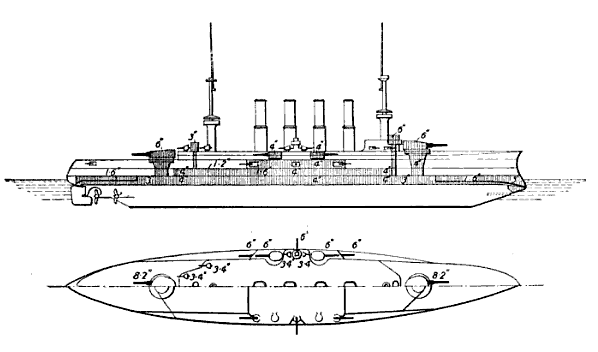
Hull & protection
The Roon class hull was 127.30 meters (417 ft 8 in) long at the waterline, and 127.80 m (419 ft 3 in) overall. The beam was 20.20 m (66 ft 3 in) at the largest frame, while they had a draft of 7.76 m (25 ft 6 in), for a total displacement between 9,533 metric tons (9,382 long tons) (normal) and 10,266 metric tons (10,104 long tons) fully loaded. So in short they were slightly longer, slightly thinner and with less draft and less tonnage than the Prinz Adalbert, and two more boilers were supposed to give them a great speed boost all combined: 22 knots instead of 19. This proved too optimistic.
The hull’s construction called for transverse and longitudinal steel frames with steel hull plates riveted on as previous cruisers. Below the armoured deck were managed twelve watertight compartments, with a double bottom below, running for 60% of the tota lenght.
SMS Roon and Yorck had Krupp cemented steel armor and on the waterline they had an armored belt 100 mm (3.9 in) thick (amidships) betwene barbettes, so around the vitals. It decreased down to 80 mm (3.1 in) on both ends of the central section. This armoured belt was backed by a layer ot teak, 55 mm (2.2 in) thick, acting as buffer. The casemate deck was protected by side armor 100 mm thick. The armored deck was 40 mm up to 60 mm (1.6–2.4 in), connected to the belt using sloped armor 40–50 mm (1.6–2.0 in) thick. The forward conning tower walls were 150 mm (5.9 in) on thickness with a 30 mm (1.2 in) roof. The rear conning tower was, as usual also, thinner, with 80 mm walls, 20 mm (0.79 in) roof. The main battery gun turrets frontal arc was protected by 150 mm thick plates and 30 mm roofs. The secondary (15 cm) turrets had 100 mm thick front and sides, 80 mm gun shields. Main Barbettes were about 150 mm, secondary 80 mm.
This armour scheme was in no way revolutionary, it ticked all the boxes of previous ships, going down to SMS Prinz Heinrich, but still was way less than the Prinz Adalbet class. The reason of this decrease was the same as two more boilers and a thinner beam, draft and tonnage: Achieving a better speed. But this was quite a price to pay for two more knots only usable when the sea calm.
Powerplant & mobility
Powerplant arrangement
SMS Roon and Yorck had basically the same engine arangement as the Prinz Adalbert, using three 3-cylinder vertical triple expansion engines(VTE), driving each a screw propeller. The central propeller was 4.50 m (14 ft 9 in) in diameter, while the outer ones were 4.80 m (15 ft 9 in). The central one could be use for cruising, the outer for high speed manoeuvers.
The only real change was the use of sixteen Düsseldorf-Ratinger Röhrenkesselfabrik (Dürr) coal-fired water-tube boilers, instead of 14, so two more. Each had 4 fireboxes, making for a grand total of 48. These boilers were ducted into not three, but four funnels, making the easiest dinstinction between the Roon and Prinz Adalbet class. This ensemble produced together 19,000 ihp (14,200 kW), allowing for a top speed of 22 knots (41 km/h).
At sea
On trials, none proved able to reach this designed and contracted speed. Roon managed to reached 21.1 knots (39.1 km/h; 24.3 mph) and Yorck 20.4 knots (37.8 km/h; 23.5 mph). For electrical outfitting, both cruisers called for four turbo generators in all, producing a total of 260 kilowatts/110 volts. Like the previous cruisers however, the Roon class proved to be good sea boats. Even fully loaded they had a gentle motion and manoeuvred well, responsive to the helm, despite a single rudder steering. Hard over however they heeled and lost 60% speed.
They were stable, with their metacentric height of 1.04 m (3 ft 5 in). Their range was 4,200 nmi (7,800 km; 4,800 mi) at 12 knots (22 km/h; 14 mph), less than the Prinz Adalbert class.
Complement was 35 officers, and 598 enlisted sailors and as squadron flagship, they had accommodations for extra 13 officers and 62 personal. A second command ship it was 9 officers, 44 personal.
Armament
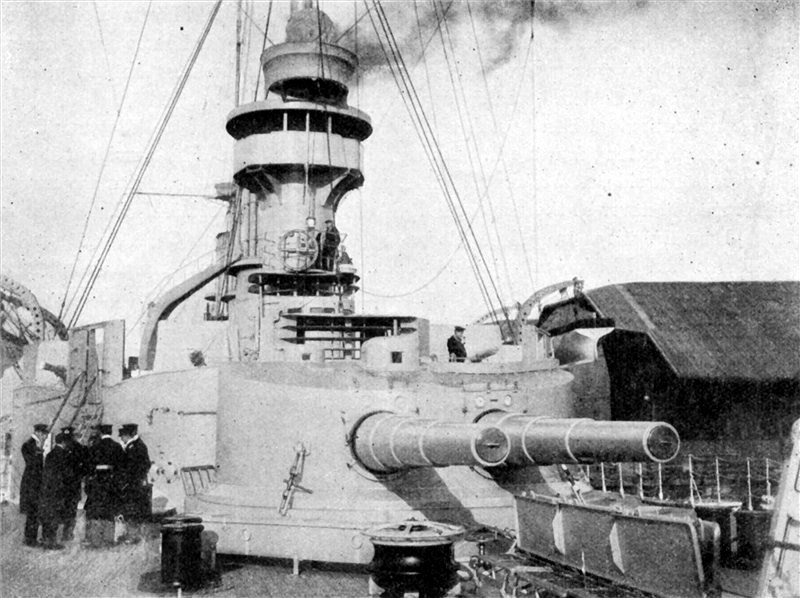
Main Battery:
Primary armament comprised four 21-centimeter (8.3 in) SK L/40 guns (40 caliber), mounted in two twin-gun turrets fore and one aft. Turrets of the DrL C/01 type had hydraulical power.
Elevation ranged from -5 to +30 degrees. They fired a 108 kg (238 lb) AP (armor-piercing) shell at a muzzle velocity of 780 meters per second (2,600 ft/s). Maximum range for the SK L/40 was 16,200 m (17,700 yd). They also had a complement of HE (High explosive) shells, and that could depend on the mission. In total, 380 shells were carried.
Secondary battery:
It comprised ten 15 cm (5.9 in) SK L/40 guns, all in single turrets, and clustered casemates amidships. This was two less than the previous Prinz Adalbert. They fired a 40 kg (88 lb) shell at 800 m/s (2,600 ft/s). They could be elevated also to 30%, providing a maximum range of 13,900 m (15,200 yd). However these casemates were placed way too low: As a result, they were always “wet” in heavy seas. To the point heavy spray prevented their use altogether. In all, 1,600 6-inches rounds were carried.
Tertiary Battery:
For close-range defense they counted on fourteen 8.8 cm SK L/35 guns. This was four more than the previous Prinz Adalbert, but the Roon were larger. They were all placed individual casemates along the upper superstructure, pivot mounts on upper decks. These guns fired a 7 kg (15 lb) shell at 770 m/s (2,500 ft/s). At max elevation (25 degrees) they reached a 9,100 m (10,000 yd) range. 2,100 shells were stored for these guns.
Torpedo Tubes:
Like previous cruisers, the Roon class was equipped with four 45 cm (17.7 in) torpedo tubes, submerged, in the bow, stern, and broadside, creating a lozenge. This was two less than the previous Prinz Adalbert. These were capable of launching the standard C/03 torpedo, which was fitted with a 147.5 kg (325 lb) warhead. The standard range gad two setups:
-1,500 m (4,900 ft) at 31 knots (57 km/h; 36 mph)
-3,000 m (9,800 ft) at 26 knots (48 km/h; 30 mph)
Old author’s Profile of Roon
Roon Specifications |
|
| Dimensions | 127.8 x 20.2 x 7.76 m (419 oa x 66 x 25 ft) |
| Displacement | 9,533 t standard, 10,226 FL |
| Crew | 35 officers, 598 ratings |
| Propulsion | 3 shafts, 14 boilers, 3 VTE engines 19,000 ihp (14,000 kW) |
| Speed | 21 knots (39 km/h; 24 mph), Range: 4,200 nmi/12 knots |
| Armament | 2×2 21 cm (8.2 in), 10 × 15 cm (5.9 in), 14 × 8.8 cm (3.5 in) SK L/30, 4 × 45 cm (18 in) TTs |
| Armor | Belt: 150 cm (7.9 in), Turrets: 20 cm (7.9 in), Deck: 3 cm (1.2 in) |
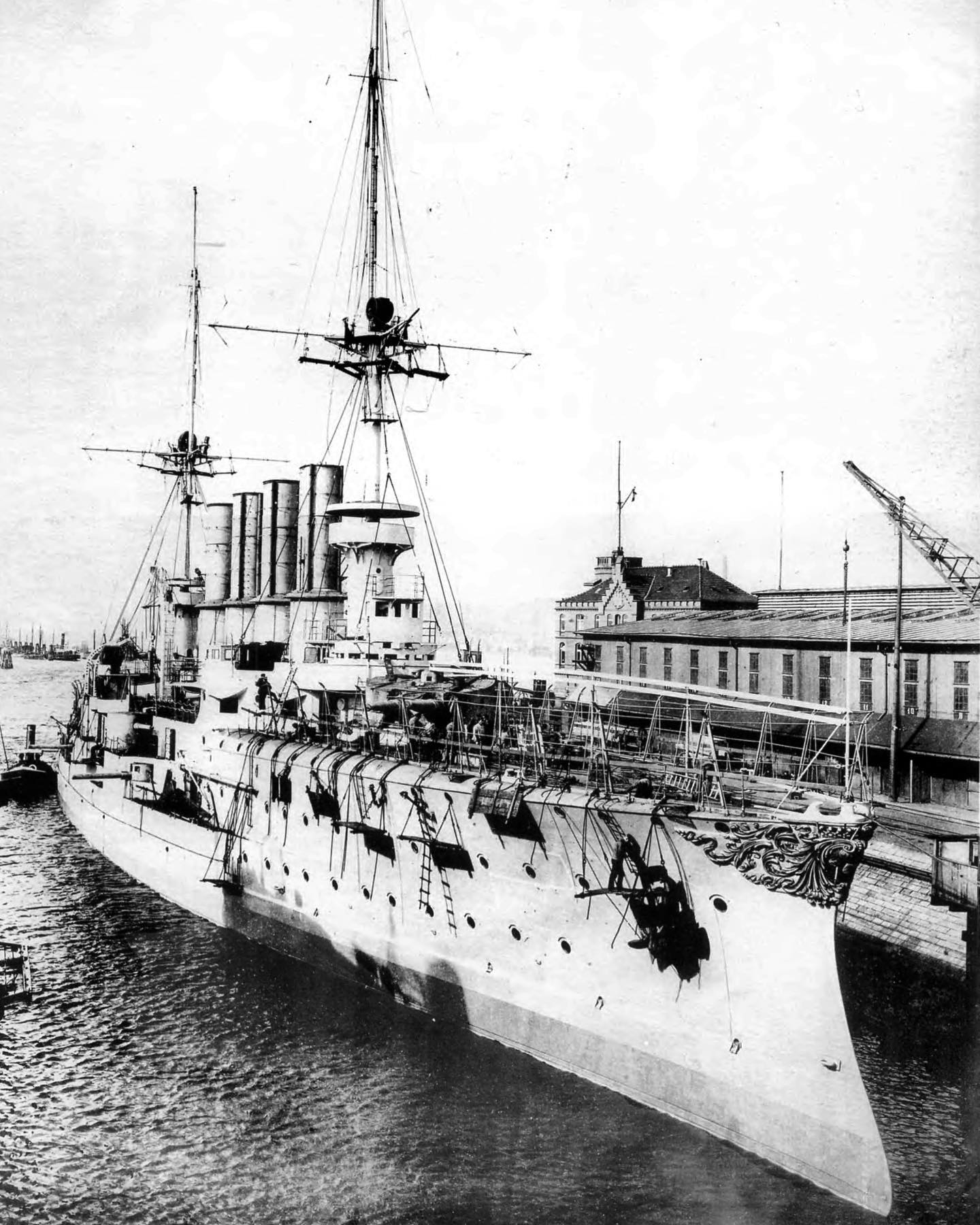
German Große Kreuzer SMS Yorck fitting out at Blohm & Voss, Hamburg, on 20 September 1905
Read More:
Books
J. Gardiner Conway’s all the world’s fighting ships 1865-1905
Dodson, Aidan (2016). The Kaiser’s Battlefleet: German Capital Ships 1871–1918. Barnsley: Seaforth Publishing.
Friedman, Norman (2011). Naval Weapons of World War One: Guns, Torpedoes, Mines and ASW Weapons of All Nations; An Illustrated Directory.
Gardiner, Robert, ed. (1979). Conway’s All the World’s Fighting Ships 1860–1905. Conway.
Gardiner, Robert & Gray, Randal, eds. (1985). Conway’s All the World’s Fighting Ships: 1906–1921.
Greger, Rene (1964). “German Seaplane and Aircraft Carriers in Both World Wars”. Warship International. Toledo: Naval Records Club, Inc. I (1–12)
Grießmer, Axel (1999). Die Linienschiffe der Kaiserlichen Marine: 1906–1918; Konstruktionen zwischen Rüstungskonkurrenz und Flottengesetz, Bonn: Bernard & Graefe Verlag.
Gröner, Erich (1990). German Warships: 1815–1945. I: Major Surface Vessels. Annapolis: Naval Institute Press.
Herwig, Holger (1998) [1980]. “Luxury” Fleet: The Imperial German Navy 1888–1918. Amherst: Humanity Books.
Hildebrand, Hans H.; Röhr, Albert & Steinmetz, Hans-Otto (1993). Die Deutschen Kriegsschiffe (Band 7/8) (in German).
Massie, Robert K. (2003). Castles of Steel. New York City: Ballantine Books.
Pavlovich, Nikolaĭ Bronislavovich (1979). The Fleet in the First World War: Operations of the Russian Fleet. New Delhi: Amerind Pub. Co.
Scheer, Reinhard (1920). Germany’s High Seas Fleet in the World War. London: Cassell and Company, ltd.
Staff, Gary (2006). German Battlecruisers: 1914–1918. Oxford: Osprey Books.
Taylor, John (1970). German Warships of World War I. Garden City: Doubleday.
Tucker, Spencer E. (2005). The Encyclopedia of World War I. ABC-CLIO.
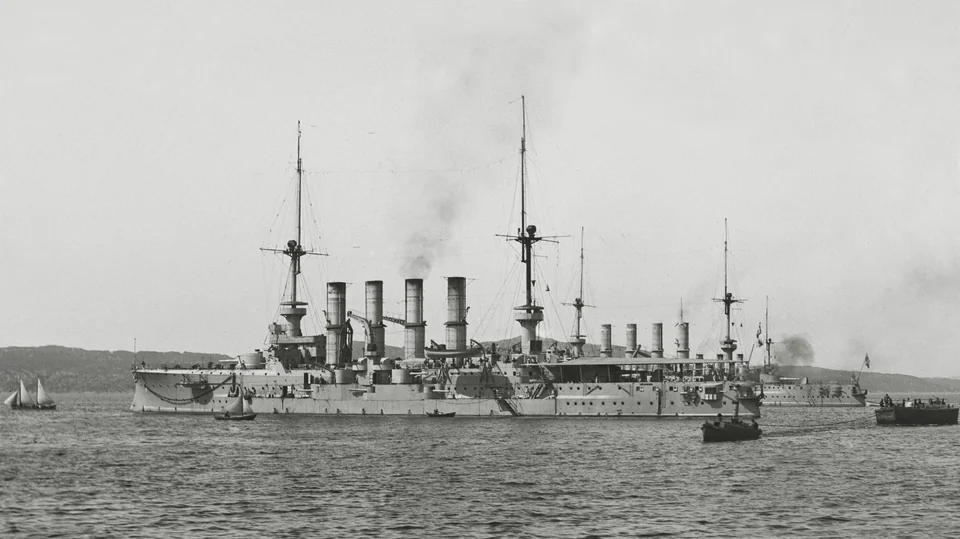
The two Roon-class armoured cruisers SMS Yorck and SMS Roon in Norway (reddit)
Links
on historyofwar.org/
on navypedia.org/
More CC photos – commons.wikimedia.org
the class on wikipedia.org
on alchetron.com
on worldnavalships.com
on worldwar1.co.uk
3D

3D model by Tom fsx on Free 3D in 3dsmax format
The ship is also featured in the naval video game Distant Guns: Jutland
Model Kits
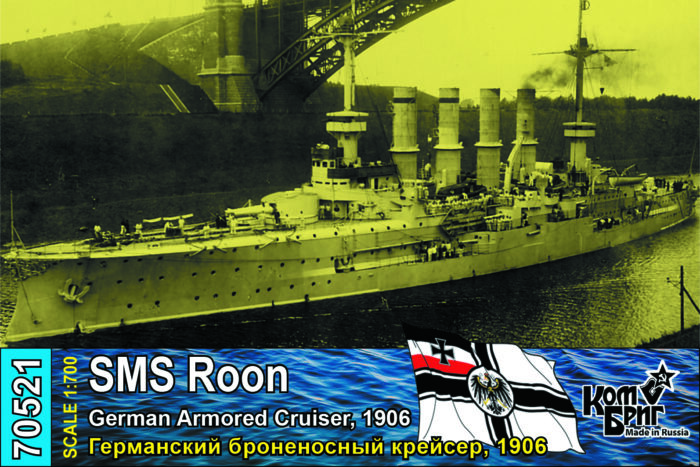
Official Kombrig page on the 1:700 model
Kombrig 1:700 kit on scalemates.com/
small 3d printed on for board games – historicalboardgaming.com
Review of the 1:350 Kombrig model on steelnavy.net
⚠ Note: Post rewritten on 26/05/2023
❯❯❯❯❯❯❯❯❯❯❯
The Roon class in service
SMS Roon
SMS Roon was ordered as “Ersatz Kaiser” as a replacement for the old ironclad “Kaiser”. She was fitted-out and modified to be used as flagship, before commission on 5 April 1906 under her first commander Kapitän zur See (KzS) Fritz Hoffmann. She performed her sea trials that lasted until 9 July, showing no issue. After brief post-fix work, she joined I Scouting Group (15 August) replacing the older SMS Friedrich Carl as flagship, deputy commander & Kommodore Raimund Winkler. After taking part in the annual fleet maneuvers by late August to early September she saw the arrival of her new captain Ksz Oskar von Platen-Hallermund, followed by KzS Karl Zimmermann, now under supervision of Kommodore Eugen Kalau vom Hofe in October.
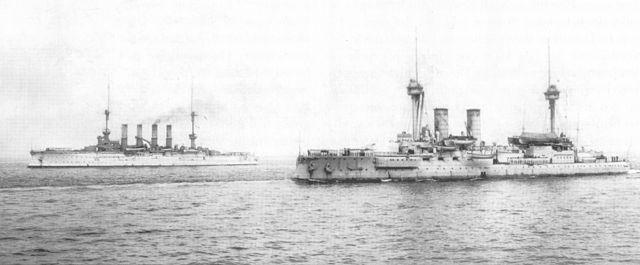
SMS Brandenburg and Roon in 1906
Prewar Operations (1906-1911)
She took part in training exercises and cruises the next years, with the I Scouting Group and High Seas Fleet. By 1907 however she made a cruise to the United States for Jamestown Exposition (300th anniversary of the colonists arrival in Chesapeake Bay) with SMS Bremen, leaving Kiel on 8 April and arriving on the 24th. Bremen remained, but Roon returned to Germany, arriving on 17 May.
From 11 September to 28 October 1907 Roon remained as deputy flagship until Yorck’s overhaul was complete and she had a new captain, FK Friedrich Schrader. She cruised the Atlantic 7-28 February 1908 with the scouting group, making tactical exercises and communicating via wireless telegraphy to the HQ and between them. They recal at Vigo in Spain and their way back. In March Roon had a new deputy commander aboard, Konteradmiral Kalau von Hofe back.
After another summer atlantic cruise, with the battleship squadron under command of Prince Heinrich, she was prepared for overseas operations in the context of the Anglo-German naval arms race, back on 13 August. Autumn maneuvers (27 August to 12 September) were done, while KAdm Jacobsen became new commander, FK Georg Scheidt as captain.
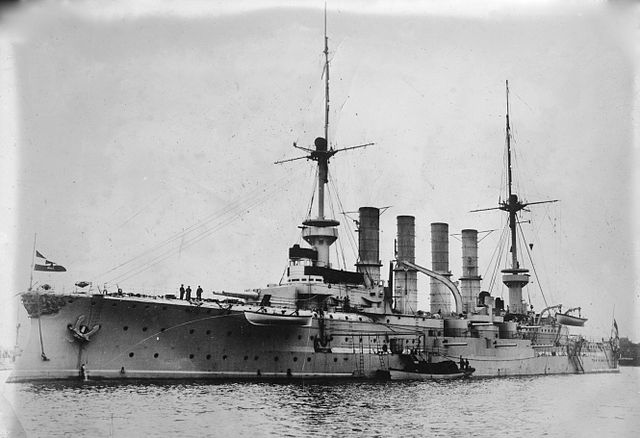
SMS Roon photographed during an USN visit in 1907
Februay 1909 saw manoeuvers in the Atlantic (I Scouting Group only) and summer Hochseeflotte’s. The ship made a show off at Spithead, Britain. Later KzS Reinhard Koch relieved Jacobsen and Roon took part in the winter 1909 manoeuvers, then the deputy commander transferred his flag to Yorck. The training routine repeated in 1910-11, apart a naval review for the Kaiser in September 1911.
She was decommissioned on 22 September for an overhaul and in reserve for budgetary reasons, allowing more funds and crews for other, more modern vessels.
Early Operations (August-December 1914)
By July 1914, Roon was remobilized and on 2 August initially assigned to II Scouting Group as flagship (KAdm Gisberth Jasper) under command of KzS Johannes von Karpf. But she was reassigned to the IV Scouting Group, replacing SMS Blücher. Her group was renamed the IIIrd on 25 August, and she was still its flagship albeit KAdm Hubert von Rebeur-Paschwitz replaced Jasper. The 26th they made a sortie into the eastern Baltic Sea, trying to rescue the stranded SMS Magdeburg in Russian waters, this was cancelled however as she was captured in between.
The 3rd group was stationed in North Sea from 6 September, making a sortie in the Skagerrak (25-26 September) after false reports. Later she escorted the minelaying cruisers Nautilus and Albatross and auxiliary minelayer Kaiser laying the “Alpha” defensive minefield. They also accompanied the sortie on Yarmouth on 2–3 November.

Roon with the Hochseeflotte
Raid on Scarborough
By 15–16 December 1914 she she took part also in the raid on Scarborough, Hartlepool and Whitby with SMS Prinz Heinrich, in the van of the High Seas Fleet, distant cover for Hipper’s battlecruisers, taking no part in the bombardment. However with her escorting destroyers she spotted the destroyers HMS Lynx and Unity, but had no time to fire as the fog masked them. News were sent to Admiral von Ingenohl which ordered the Hochseeflotye to disengage, Roon becoming the rearguard, soon joined by SMS Stuttgart and Hamburg. They met underway Asmiral Loftus Jone’s destroyers, being shadowed for about 45 minutes until Stuttgart and Hamburg sallied forward in attack and drove them off. But 20 mm later Roon signaled them to abandon pursuit and return. Vice Admiral David Beatty tried to intercept them with HMS New Zealand until learning about the bombardment of Hartlepool, so he broke off the pursuit and verred towards them. This probably saved Roon, as the firepower of HMS New Zealand, an Indefatigable-class ship, was way above her capabilities (and faster).
Transfer to the Baltic
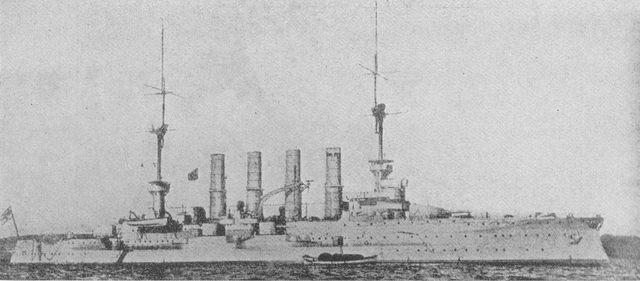
At that point the admiralty realized Roon and in general armored cruisers were too slow to be part of a Scouting Group, too weak for their potential aversaries in the North Sea, and so by 15 April 1915, Roon and the III Scouting Group were transferred to the Baltic as the Russian Baltic Fleet posed less of a threat. The group was discarded and instead she became part of the “Reconnaissance Forces of the Baltic” (KAdm Albert Hopman). FK Hans Gygas replaced Karpf as new deputy commander, Roon maintaine as his flagship.
On 30 April she was drydocked and overhauled in Kiel, and out of this, making sea trials and preparation for the raid on Libau, on 7 May 1915. On 11 May British submarine E9 spotted her en route and fired five torpedoes but missed. Roon later made other sorties in the central Baltic until late June.
Karpf transferred his flag to the light cruiser SMS Lübeck and Hopman returned to Roon as SMS Prinz Adalbert, torpedoed, was under repairs. Roon and Lübeck covered Albatross minelaying mission on 30 June-2 July and took part in the Battle of Åland Islands: Augsburg and three destroyers were escorting Albatross when attacked by Bayan, Admiral Makarov, Bogatyr and Oleg. Augsburg escaped while Albatross, severely damaged, took refuge in Swedish waters, Roon joining Lübeck to try to rescue the chased German destroyers. Roon engaged Bayan first, Lübeck Oleg. However soon Rurik (an adversary worthy of Roon) arrived and the artillery duel turned badly for Roon, hit several times and eventually forced to retreat. This showed the baltic was not a promenade either.

The Rurik, a worthy adversary to Roon (colorized by Irootoko Jr)
Later in July Roon and her group started to cover operations of the advancing German Army north from Libau. They also covered the pre-dreadnought battleships of the IV Battle Squadron also deployed on the eastern Baltic under Vizeadmiral Ehrhard Schmidt. In August they were sent in the Gulf of Riga but failed to force their way into the gulf (Battle of the Gulf of Riga) until reports of British submarines forced them out 20 August. Roon on 10 August with Prinz Heinrich shelled Russian positions at Zerel (Sworbe Peninsula) and surprised Russian destroyers at anchor, one being badly damaged.
On 9 September, Hopman returned his flag to Prinz Adalbert so as Roon could be overhauled in Kiel until mid-October, returning to Libau on 18 October, and flagship. Prinz Adalbert three days later was sunk by a British submarine and so the admiralty decided to retired Roon, considered having a weak ASW protection. By 15 January 1916 she was no longer flagship, reuturned to Kiel, being decommissioned on 4 February.
By November 1916 she was disarmed, converted into a training/accommodation ship in Kiel with a smaller skeleton crew, her crew being sent to more modern ships. She served there until 1918 until the admiralty decided to convert her as a seaplane carrier, having already experimented this with SMS Stuttgart in 1918, limited to two aircraft. Roon made a better potential seaplane carrier and conversion commenced to carry four aircraft. It was planned to removed her main battery, replaced with six 15 cm gun, six 8.8 cm AA guns, large hangar installed aft of the main superstructure, but this was cancelled as the Navy wanted to rely on zeppelins for aerial reconnaissance in the end. Roon was stricken on 25 November 1920, scrapped in Kiel-Nordmole.
SMS Yorck
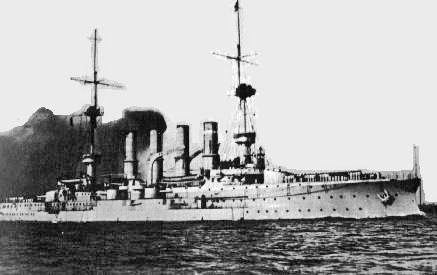 Yorck was ordered as “Ersatz Deutschland” to Blohm & Voss, Hamburg commemorating Ludwig Yorck von Wartenburg (Prussian general or the Napoleonic Wars), completed by late 1905. She made her builder’s trials, was transferred to Kiel, to be properly commissioned on 21 November. She was transferred to the I Scouting Group on 27 March 1906, replacing on 2 April as flagship the older Friedrich Carl, under Vizeadmiral Gustav Schmidt.
Yorck was ordered as “Ersatz Deutschland” to Blohm & Voss, Hamburg commemorating Ludwig Yorck von Wartenburg (Prussian general or the Napoleonic Wars), completed by late 1905. She made her builder’s trials, was transferred to Kiel, to be properly commissioned on 21 November. She was transferred to the I Scouting Group on 27 March 1906, replacing on 2 April as flagship the older Friedrich Carl, under Vizeadmiral Gustav Schmidt.
Prewar Operations (1906-1914)
For several years she followed the usual peacetime routine of training exercises with the fleet (reconnaissance forces) and major fleet exercises in setup seasons in summer and winter.
On 29 September 1907 Konteradmiral Hugo von Pohl hoisted his flag in turn. Yorck was overhauled 11 September-28 October, replaced by Friedrich Carl. Later she returned as flagship, under KAdm August von Heeringen. She cruised the Atlantic 7-28 February 1908 with the scouting group between tactical exercises and wireless telegraphy tests, recoaling in Vigo, Spain. However in May she was replaced as flagship by SMS Scharnhorst.
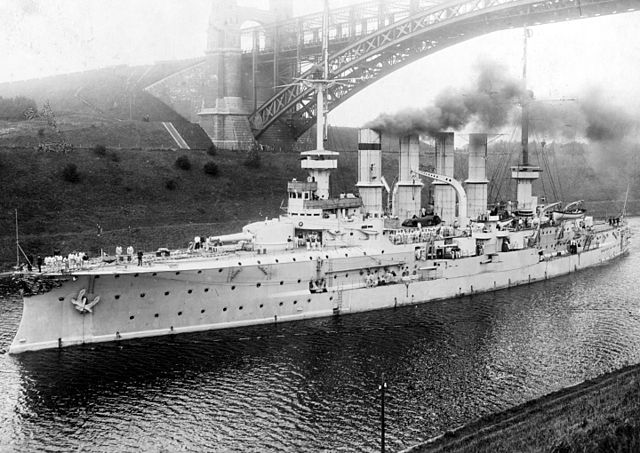
Yorck through the Kiel Canal
She made another summer Atlantic cruise with the High Seas Fleet under Prince Heinrich. Yorck stopped in Funchal, Madeira and Coruña in Spain and was back home on 13 August. The autumn maneuvers followed until 12 September in which she was awarded the Schießpreis (Shooting Prize) for this year. Erich Raeder became her new navigation officer at that time. In October, KzS Arthur Tapken took command (until September 1909).
In February 1909, I Scouting Group made another Atlantic training cruise but Scharnhorst was detached to the newly created East Asia Squadron on 11 March, so the role of flagship returned to Yorck for Heeringen and his staff. After another Atlantic cruise in the summer, Yorck visited Vilagarcía de Arousa (18-26 July) and stopped in Spithead. By early 1910 SMS Blücher recenlty commissioned was replaced Yorck as flagship on 25 April. Yorck later however became flagship of deputy commander KAdm Reinhard Koch, then KAdm Gustav Bachmann and KAdm Maximilian von Spee (future head of the East Asia Sqn.) on 15 September. Yorck won the Schießpreis again for the 1909–1910 year and had KzS Ludwig von Reuter as new deputy Cdr. from September 1910.
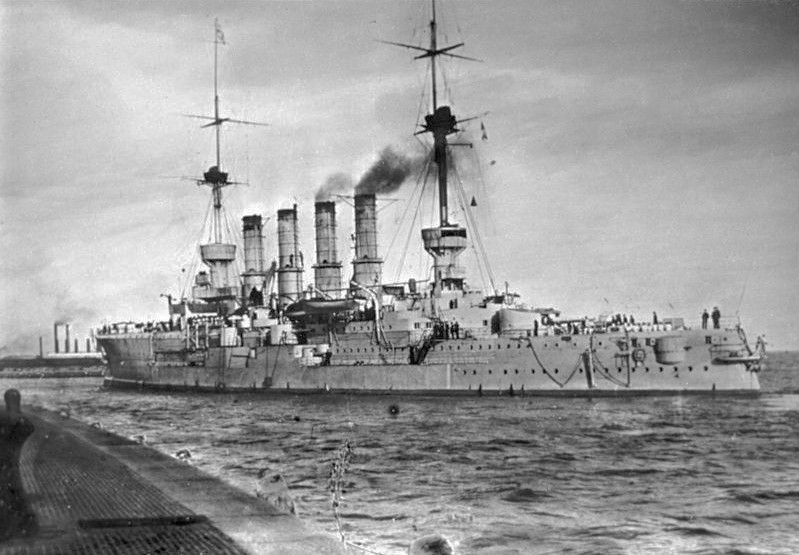
SMS Yorck’s stern
On 31 March 1911 while in a routune maintenance she suffered a benzene explosion in her aft-most boiler room. She had one stoker killed, several injured and so due to repairs, missed the maneuvers. On 1 October, KzS Franz von Hipper replaced Spee after which her group cruised to Norway and Sweden by November, stopping at Uddevalla (3-6) but Yorck missed the next maneuvers of February 1912. In March she was replaced in the group bt four light cruisers, but remained as flagship under VAdm Bachmann, until Von der Tann became the new flagship. Her new captain became Ksz Max Köthner but she had another accident on 2 November (one pinnace accidentally detonated a naval mine). She had two more sailors killed, two wounded.
Yorck had yet another accident on 4 March 1913 during training off Helgoland as the torpedo boat S178 attempting to pass in front missed her manoeuver and Yorck’s ram bow slammed into her, the breach being severe enough to have her flooded and sinking in minutes, with 69 men going with her. Yorck and Oldenburg only rescued 15. Yorck was only slightly damaged and went on with the maneuvers. KAdm Felix Funke replaced Bachmann, but the latter returned later and Funke again, Yorck being finally decommissioned in Kiel on 21 May leaving the I Scouting Group for ever. She was also the last armoured cruiser in any scouting group. After an overhaul she was placed in reserve her crew transferred to Seydlitz.
Early War Operations – North Sea
Remobilized, recommissioned on 12 August she was assigned to the IV Scouting Group, then IIIrd (KAdm Hubert von Rebeur-Paschwitz) and from 20 September, patrolled the German Bight, before transfer to the Baltic Sea for a sortie to Östergarn (22-29 September) and bacl to to the North Sea. On 3 November she assisted the I Scouting Group’s raid on Yarmouth, statying s distant cover until the British counterattack. She also provided the reconnaissance screen and ws back Wilhelmshaven lateer that day in heavy fog, so to avoid minefields she ended in the Schillig roadstead.
Yorck’s last commander (KzS Pieper) believed the fog had cleared enough to proceed, and so got underway, although the ship’s pilot refused to take responsibility to sail into the minefields and as it was awaited, at 04:10, Yorck struck a mine. While trying to turn to exit the minefield she struck another and this was fatal. The very fast flooding had her capsizing with seconds, sinking with almost all hands. Sources disagree however between 127 (out of 629) or 336, then 381 rescued, notably by the coast defense ship SMS Hagen.
Captain Pieper, which survived, was court-martialled, convicted, and sentenced to two years’ imprisonment. The shipwreck, wid-way between Horumersiel and Hooksiel posed no navigation hazard but it was ultimately scrapped in 1926 and completely in 1936–1937, her turrets only removed in 1969, the remainder in 1983 to clear the sea floor.

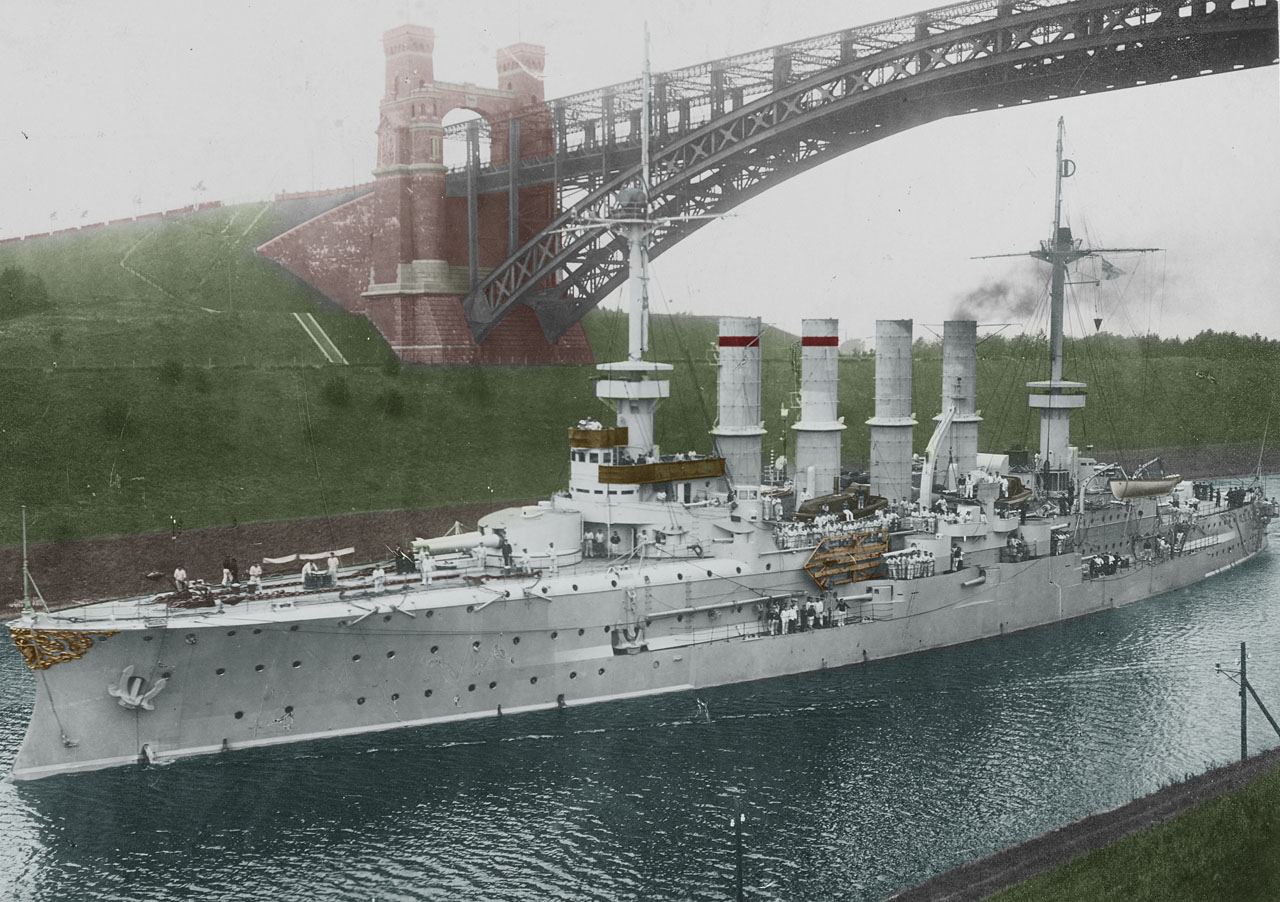
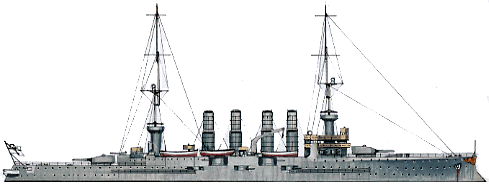
 Latest Facebook Entry -
Latest Facebook Entry -  X(Tweeter) Naval Encyclopedia's deck archive
X(Tweeter) Naval Encyclopedia's deck archive Instagram (@navalencyc)
Instagram (@navalencyc)





 French Navy
French Navy Royal Navy
Royal Navy Russian Navy
Russian Navy Armada Espanola
Armada Espanola Austrian Navy
Austrian Navy K.u.K. Kriegsmarine
K.u.K. Kriegsmarine Dansk Marine
Dansk Marine Nautiko Hellenon
Nautiko Hellenon Koninklije Marine 1870
Koninklije Marine 1870 Marinha do Brasil
Marinha do Brasil Osmanlı Donanması
Osmanlı Donanması Marina Do Peru
Marina Do Peru Marinha do Portugal
Marinha do Portugal Regia Marina 1870
Regia Marina 1870 Nihhon Kaigun 1870
Nihhon Kaigun 1870 Preußische Marine 1870
Preußische Marine 1870 Russkiy Flot 1870
Russkiy Flot 1870 Svenska marinen
Svenska marinen Søværnet
Søværnet Union Navy
Union Navy Confederate Navy
Confederate Navy Armada de Argentina
Armada de Argentina Imperial Chinese Navy
Imperial Chinese Navy Marinha do Portugal
Marinha do Portugal Mexico
Mexico Kaiserliche Marine
Kaiserliche Marine 1898 US Navy
1898 US Navy Sovietskiy Flot
Sovietskiy Flot Royal Canadian Navy
Royal Canadian Navy Royal Australian Navy
Royal Australian Navy RNZN Fleet
RNZN Fleet Chinese Navy 1937
Chinese Navy 1937 Kriegsmarine
Kriegsmarine Chilean Navy
Chilean Navy Danish Navy
Danish Navy Finnish Navy
Finnish Navy Hellenic Navy
Hellenic Navy Polish Navy
Polish Navy Romanian Navy
Romanian Navy Turkish Navy
Turkish Navy Royal Yugoslav Navy
Royal Yugoslav Navy Royal Thai Navy
Royal Thai Navy Minor Navies
Minor Navies Albania
Albania Austria
Austria Belgium
Belgium Columbia
Columbia Costa Rica
Costa Rica Cuba
Cuba Czechoslovakia
Czechoslovakia Dominican Republic
Dominican Republic Haiti
Haiti Hungary
Hungary Honduras
Honduras Estonia
Estonia Iceland
Iceland Eire
Eire Equador
Equador Iran
Iran Iraq
Iraq Latvia
Latvia Liberia
Liberia Lithuania
Lithuania Mandchukuo
Mandchukuo Morocco
Morocco Nicaragua
Nicaragua Persia
Persia San Salvador
San Salvador Sarawak
Sarawak Uruguay
Uruguay Venezuela
Venezuela Zanzibar
Zanzibar Warsaw Pact Navies
Warsaw Pact Navies Bulgaria
Bulgaria Hungary
Hungary

 Bundesmarine
Bundesmarine Dutch Navy
Dutch Navy Hellenic Navy
Hellenic Navy Marina Militare
Marina Militare Yugoslav Navy
Yugoslav Navy Chinese Navy
Chinese Navy Indian Navy
Indian Navy Indonesian Navy
Indonesian Navy JMSDF
JMSDF North Korean Navy
North Korean Navy Pakistani Navy
Pakistani Navy Philippines Navy
Philippines Navy ROKN
ROKN Rep. of Singapore Navy
Rep. of Singapore Navy Taiwanese Navy
Taiwanese Navy IDF Navy
IDF Navy Saudi Navy
Saudi Navy Royal New Zealand Navy
Royal New Zealand Navy Egyptian Navy
Egyptian Navy South African Navy
South African Navy






























 Ukrainian Navy
Ukrainian Navy dbodesign
dbodesign